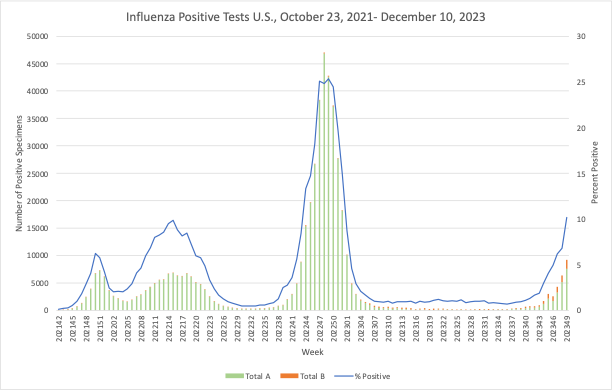The pandemic may have been declared over, but COVID is not gone. In fact, as with any seasonal virus, it is once again on the rise. And as many such viruses do (e.g., influenza), it has once again mutated to new strains.
Since CDC first posted on BA.2.86 in August 2023, the proportion of infections caused by this variant has quickly increased. Add to that a second variant, JN.1 – which is a descendent of and was previously grouped with BA.2.86 – and concern is increasing among both health experts and the public.
Worldwide, the proportion of JN.1 rose from 3.3% in early November to 27.1% by early December, with the WHO seeing the highest proportions reported in the U.S., Canada, France, Singapore, and the UK. CDC estimated that JN.1 comprised an estimated 15–29% of cases in the U.S. as of December 8, 2023. It is currently the fastest growing variant in the U.S. and CDC expects it to continue to increase as a proportion of COVID cases. In Minnesota alone, where wastewater data is tracked, there has been an estimated 61% increase in viral load in the last two weeks.
The continuing rise of the variant suggests that it is more transmissible or better at evading human immune systems, however, CDC sees “no evidence that JN.1 presents an increased risk to public health relative to other currently circulating variants.” This is because JN.1 is showing no indication of increased severity, and the 2023 updated vaccine, tests, and treatments are all expected to be effective against this variant as well.
Thus, it is important that businesses continue to encourage employees to get both COVID and influenza vaccines (which CDC assures can be acquired at one time) and to stay home when ill. While both COVID and influenza pose potentially serious long-term health threats, studies show that COVID remains a much more formidable threat. Because of this, the WHO is recommending preventive actions similar to those during the pandemic including masking in health facilities and any crowded, enclosed, or poorly ventilated areas; keeping a safe distance from others, as feasible; improved ventilation; personal hygiene (handwashing, covering coughs and sneezes, etc.); testing if symptomatic or exposed; and, as we have so often repeated ourselves, staying home when ill.
COVID Risk Matrix:

Influenza:


Infectious Disease News:
- Kerala, a southern state of India has witnessed an increase of JN.1 Covid cases. JN.1 was previously classified as a variant of interest as part of BA.2.86 but is now being classified separately due to its rapidly increasing spread. Officials have continued to encourage individuals not to panic. WHO says that all currently approved Covid vaccines will continue to provide protection against JN.1.
- Many Canadians have had long Covid for almost 4 years – including some individuals that had such bad brain fog they could no longer work full time. 42% of people in Canada reported lasting symptoms for a year or more – some of which still haven’t resolved.
- Detection of skin rashes after the chicken pox vaccine were found to be linked to infection with wild type strains of the varicella-zoster virus, which is not unexpected.
- In France, invasive meningococcal disease (IMD) cases declined upon the implementation of non-pharmaceutical measures to control the COVID-19 pandemic. A rebound in IMD cases was feared upon easing these measures and that has been happening since mid-2022.
- The Tacoma-Pierce County Health Department said a tuberculosis outbreak in the Washington state prison system may have affected more than 800 people who were incarcerated and later released. These 800 may have been exposed to one of the 28 people whose active TB was diagnosed.
- Avian flu outbreaks struck poultry flocks in 12 states over the past week, hitting seven more commercial farms, including a California one that houses more than 1.3 million layers. Detection of avian flu started ramping back up in early October. Last month more than 8 million birds were lost and so far this month owners have lost more than 7.2 million birds. Since the outbreaks began in 2022, 75.4 million birds have been killed across 47 states.




